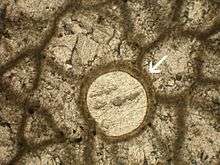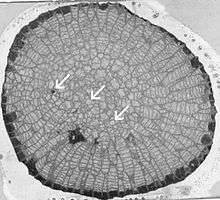Chaetosalpinx
Chaetosalpinx is an ichnogenus of bioclaustrations (a type of trace fossil). Chaetosalpinx includes straight to sinuous cavities that are parallel to the host's axis of growth. The cavity is circular to oval in cross-section and it lacks a wall lining or floor-like tabulae.[1] They are common in tabulate and rugose corals from Late Ordovician to Devonian of Europe and North America.[1][2][3][4] They may have been parasites.[5]

Chaetosalpinx sibiriensis in Paleofavosites cf. collatatus, Bagovitsa A, Ukraine, Muksha subformation, Ludlow, transverse section, the arrow points to C. sibiriensis
| Chaetosalpinx | |
|---|---|
 | |
| Chaetosalpinx sibiriensis in Paleofavosites cf. collatatus, Bagovitsa A, Ukraine, Muksha subformation, Ludlow, transverse section, the arrows point to C. sibiriensis. | |
| Trace fossil classification | |
| Ichnogenus: | †Chaetosalpinx Sokolov, 1948 |
References
- Tapanila, L. (2005). "Palaeoecology and diversity of endosymbionts in Palaeozoic marine invertebrates: Trace fossil evidence". Lethaia. 38 (2): 89–99. doi:10.1080/00241160510013123.
- Mõtus, M.-A.; Vinn, O. (2009). "The worm endosymbionts in tabulate corals from the Silurian of Podolia, Ukraine" (PDF). Estonian Journal of Earth Sciences. 58 (3): 185–192. doi:10.3176/earth.2009.3.03. Retrieved 2013-07-31.
- Vinn, O.; Mõtus, M.-A. (2012). "Diverse early endobiotic coral symbiont assemblage from the Katian (Late Ordovician) of Baltica". Palaeogeography, Palaeoclimatology, Palaeoecology. 321–322: 137–141. Bibcode:2012PPP...321..137V. doi:10.1016/j.palaeo.2012.01.028. Retrieved 2014-06-11.
- Vinn, O.; Wilson, M.A.; Mõtus, M.-A. (2013). "Symbiotic worm endobionts in a stromatoporoid from the Rhuddanian (lower Silurian) of Hiiumaa, Estonia". PALAIOS. 28: 863–866. doi:10.2110/palo.2013.078. Retrieved 2014-06-11.
- Zapalski, M. K. (2007). "Parasitism versus commensalism: the case of tabulate endobionts". Palaeontology. 50 (6): 1375–1380. doi:10.1111/j.1475-4983.2007.00716.x.
This article is issued from Wikipedia. The text is licensed under Creative Commons - Attribution - Sharealike. Additional terms may apply for the media files.